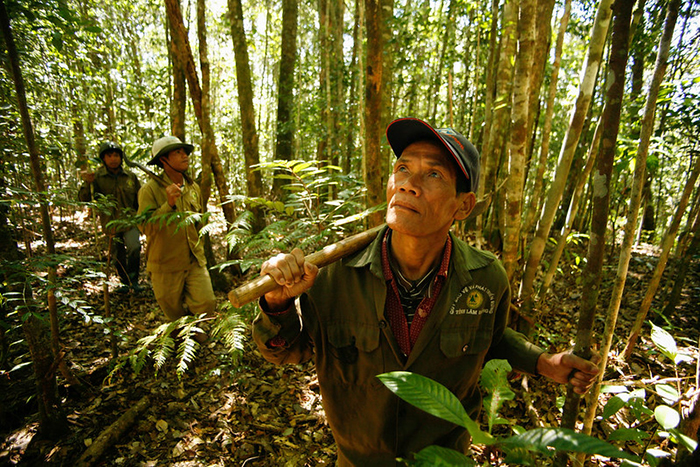Post-Pandemic Priorities for Biodiversity Conservation and Wildlife Management in the GMS

The GMS Biodiversity Conservation Corridors Project in Viet Nam provided alternative incomes to K’ho natives like Cil Yu Ha Vuong, who patrols the forest with his fellow community members. Photo by ADB.
The coronavirus disease (COVID-19) pandemic has proved how human health, animal health, plant health, and the health of the environment are all closely interconnected as “One Health”. “We have seen many diseases emerge over the years. Most of them originated from animal populations under conditions of severe environmental pressures,” said Mr. Ramesh Subramaniam, Director General, Southeast Asia Regional Department, speaking at the opening of the Greater Mekong Subregion (GMS) Working Group Meeting on Environment held via video conferencing on 23 June 2020.
Human wealth depends on nature’s health. Continuous exploitation of biodiversity and wildlife provides a more conducive environment to zoonoses, including COVID-19 type pandemics. "The alternative is to invest in climate-smart landscapes and protection of biodiversity and sustainable wildlife management," stressed Mr. Subramaniam.
Biodiversity in the GMS
The GMS harbors globally important and irreplaceable elements of biodiversity, shared Dr. Xi Jiao, who discussed the “Post-pandemic priorities for biodiversity conservation and wildlife management in the GMS.” Biodiversity and ecosystem conservation can play a role in safeguarding public health by reducing prevalence of infectious diseases, explained Dr. Jiao. Biodiversity conservation also has potential to support other interlinked global sustainable development goals, such as food security, climate action, and poverty alleviation. Furthermore, key economic sectors in the GMS all depend on the maintenance and contribution of healthy ecosystems.
“I'm not trying to emphasize the importance of biodiversity here, but rather reflecting on this complex interdependence and dynamics of all related global issues,” said Dr. Jiao. She pointed out in her presentation that biodiversity in its all forms is being lost at an unprecedented rate in the GMS. She urged policymakers, government officials, and development partners in attendance to move beyond the sectoral silo perspectives and solutions to a broader multi-sectoral approach. “How do we mainstream biodiversity considerations into other sectoral planning?” asked Dr. Jiao.
Proposed priorities for post-pandemic and post-2020 biodiversity conservation and wildlife management in the GMS
GMS countries are parties to the Convention on Biodiversity. At this critical time in the midst of the pandemic and policy planning for the post-2020 global biodiversity framework, the GMS plays an essential role in contributing toward the achievement of the 2050 Biodiversity Vision. GMS can indeed set an example to others by “mainstreaming biodiversity and wildlife management into COVID-19 recovery packages,” said Dr. Srinivasan Ancha. To safeguard the subregion’s rich biodiversity and restore its valuable ecosystem landscapes, Dr. Jiao recommended the following:
- Undertake more holistic and integrated approaches for biodiversity landscape conservation. Three interlinked strategic target areas for biodiversity conservation in the GMS are proposed: i) maintaining ecosystem integrity and biodiversity (including wildlife management), ii) sustaining ecosystem goods and services (including climate mitigation and resilience), and iii) sustainable livelihoods and development. The integrated approaches are based on the guiding principles of being ecosystem-based or nature-based solutions, promoting resilience and climate-smart considerations, and encouraging a multi-sectoral and multi-stakeholders participatory process.
- Prioritize post-pandemic measures and interventions on wildlife management. This includes strengthening regulations and law enforcement on wildlife trade and enhancing wildlife protection and habitat conservation. As many cases of wildlife trafficking in the GMS are organized crimes, multi-agency collaboration is more effective than the efforts of single agency. There is also an opportunity to utilize the COVID-19 stimulus funds to hire additional rangers and increase digital applications and remote monitoring technologies, such as through drones and camera traps, to boost wildlife protection and habitat conservation.
- Support rebuilding livelihoods without compromising biodiversity and ecosystems. The pandemic has marginalized rural communities that are reliant on natural resources as safety nets in response to income shocks, which may further threaten biodiversity conservation. Stimulus funds can be used to provide food and cash support for such communities. Local communities can be engaged in conservation work with provision of compensation. Subsidies and technical assistance can be used to facilitate transition to alternative sustainable livelihoods.
- Explore innovative financing solutions for wildlife management. It is more critical than ever during the post-pandemic, to undertake a systematic analysis of financing needs and gaps, and leverage all possible financial resources through multiple channels. Innovative solutions (e.g. BIOFIN approach) for resource allocation are critical.
- Mainstream biodiversity considerations into other sectoral planning and investments. There is an opportunity to deliver better sustainability when values and costs of biodiversity are internalized into economic and financial analysis of investment projects and when biodiversity is institutionalized into Environmental, Social and Governance (ESG) criteria for responsible investments. Biodiversity standards and credit mechanisms can also be incorporated as biodiversity offsets for infrastructure projects.
Building on joint efforts on biodiversity conservation in the GMS for more than a decade, in establishing biodiversity corridors and bringing together government and communities for integrated livelihoods and conservation initiatives, there are great opportunities for the GMS countries to move further forward on its transboundary biodiversity landscape interventions that incorporates climate change mitigation and adaptation responses.
The GMS Working Group on Environment and the GMS Working Group on Agriculture can also leverage existing subregional cooperation to enhance agricultural ecosystem biodiversity conservation and adoption of sustainable agriculture practices for a healthy food system. Both working groups can play a leadership role in integrating appropriate nature-based solutions and safeguards in COVID-19 stimulus packages to reduce the risks of future pandemics.
Last Updated: 7 August 2020
